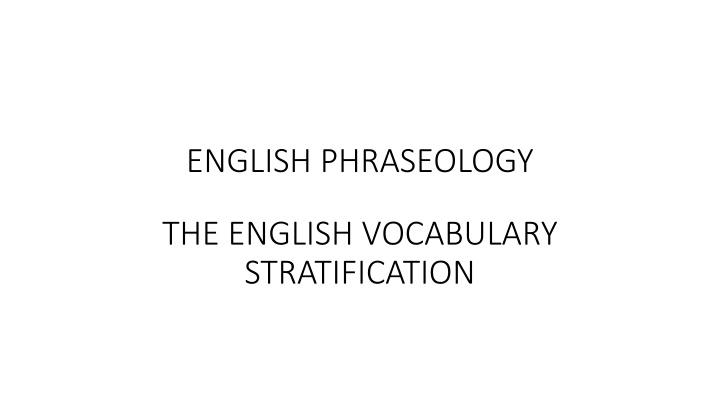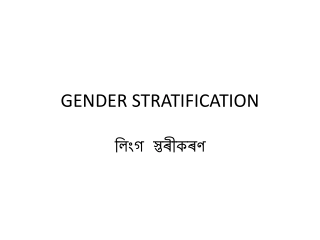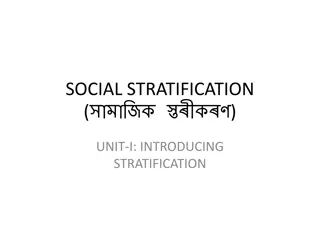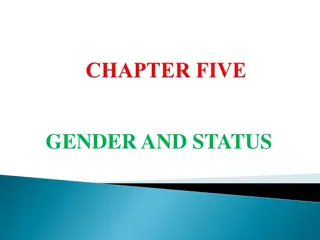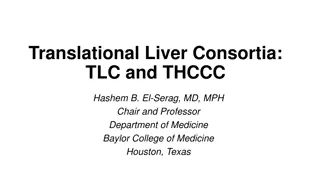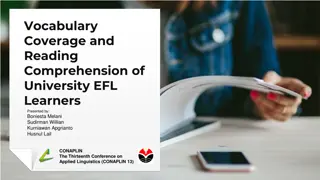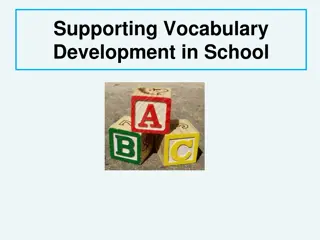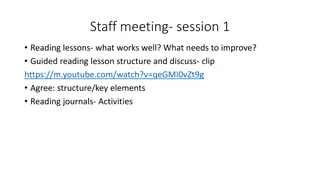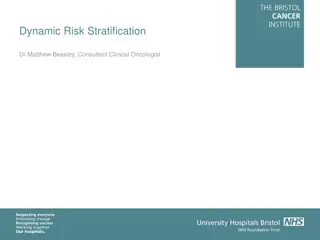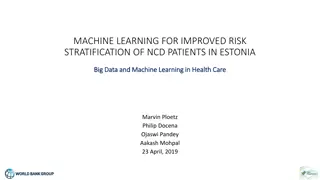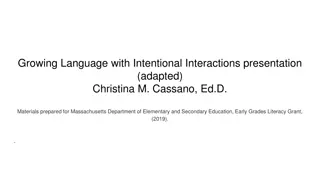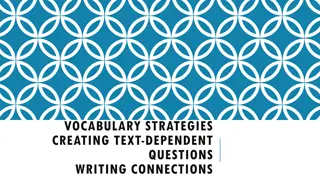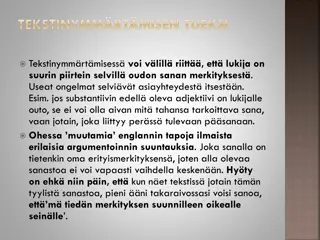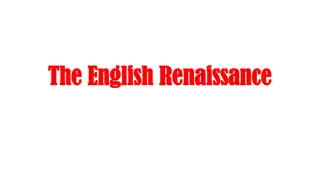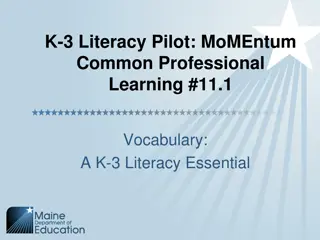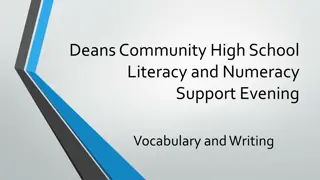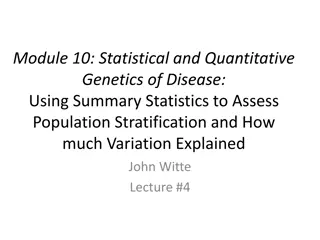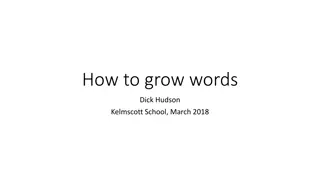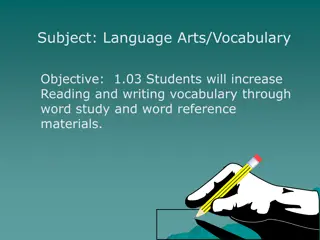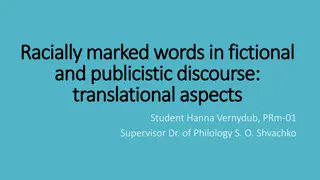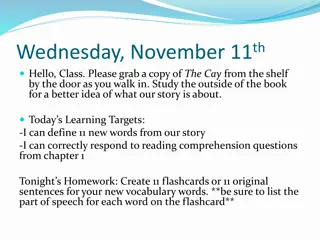ENGLISH PHRASEOLOGY.THE ENGLISH VOCABULARY STRATIFICATION.
Explore the concept of phraseological units, various classifications, categorial features, and semantic relations in phraseology, along with the stylistic stratification of the English vocabulary, covering literary words, colloquial words, and different types of word combinations. Discover how phraseological units differ from free word-groups and the classifications based on semantic criteria by Vinogradov and functional classifications by Smirnitsky, Koonin, and Amosova. Additionally, learn about the structural principle of classifying phraseological units based on parts of speech.
Download Presentation

Please find below an Image/Link to download the presentation.
The content on the website is provided AS IS for your information and personal use only. It may not be sold, licensed, or shared on other websites without obtaining consent from the author.If you encounter any issues during the download, it is possible that the publisher has removed the file from their server.
You are allowed to download the files provided on this website for personal or commercial use, subject to the condition that they are used lawfully. All files are the property of their respective owners.
The content on the website is provided AS IS for your information and personal use only. It may not be sold, licensed, or shared on other websites without obtaining consent from the author.
E N D
Presentation Transcript
ENGLISH PHRASEOLOGY THE ENGLISH VOCABULARY STRATIFICATION
Outline 1. The Concept of Phraseological Units. 2. Various Classifications of Phraseological Units. 3. Categorial Features of Phraseological Units. 4. Semantic Relations in Phraseology. 5. Stylistic Stratification of the English Vocabulary. 6. Stylistically Neutral Vocabulary. 7. Literary Words. Their Subdivisions. 8. Colloquial Words. Their Subdivisions.
Types of word combinations ordinary / free word-combinations (any element can be substituted by another) semi-free word combinations (the substitution is possible but limited, e.g. to cut a poor/funny/strange figure) non-free word combinations (the substitution is impossible, e.g. to be in low water) stable word combinations (means of expression of certain notions, e.g. sunny smile, black ingratitude, a pretty kettle of fish)
Phraseological units differ from free word-groups semantically and structurally: - single concept - structural invariability - ready-made units - completely or partially transferred meaning
Classifications of phraseological units According to V. V. Vinogradov s semantic (degree of motivation of meaning) criterion: - phraseological fusions, e.g. the king s picture ( ), to kiss the hare s foot ( ) - phraseological unities, e.g. to turn over a new leaf ( ), to make a mountain out of a molehill ( ) - phraseological collocations, e.g. to be at one s wits end ( , , ), to make friends ( ), to make sure ( ) According to prof. O. I. Smirnitsky s functional classification: - phraseological units, e.g. to bring up, to catch a cold, to take to somebody - idioms, e.g. to beat about the bush, to bark up the wrong tree
Classifications of phraseological units According to prof. O. V. Koonin s functional classification: - nominative, e.g. out of sight, as the crow flies. - nominative-communicative, e.g. to set the Thames on fire the Thames was set on fire, to break the ice the ice was broken. - interjectional, e.g. A pretty kettle of fish! Hear, hear! Good God! My aunt! - communicative, e.g. An early bird catches the worm; East or West, home is the best; Honesty is the best policy :: That s another pair of shoes! It s a small world. According to N. N. Amosova s type of context classification: - phrasemes, e.g. green hand ( ), bitter enemy ( ); - idioms, eg.: red tape ( ); mare s nest ( ).
Classifications of phraseological units The structural (parts of speech) principle of classifying phraseological units: 1) verbal, e.g. to have butterflies in the stomach, to have green fingers, 2) substantive, e.g. a dark horse, small talk, 3) adjectival, e.g. spick and span, safe and sound, 4) adverbial, e.g. by hook or by crook, by a long chalk, 5) interjectional, e.g. goodness gracious! Sakes alive!
The categorial features of phraseological units 1) stability (morphological, syntactical, semantic, etc.); 2) word-group structure (each phraseological unit consists of more than one word); 3) absence of any stereotyped pattern; 4) figurative (transferred) meaning; 5) expressiveness. A certain stable combination may be referred to some class of phraseological units only on the condition of the combination of all the above-mentioned features.
Semantic relations in phraseology Semantic relations in phraseology are the same as between words. Like words phraseological units can be related as homonyms, synonyms, antonyms. Furthermore, phraseological units may be either monosemantic or polysemantic.
Phraseological antonyms phraseological units which are opposed in their meanings, correlated according to the main semantic feature and belonging to one and the same grammatical class: have a (good) head on one s shoulders have a head like a sieve; hold all the trumps have no say in the matter. Types of phraseological antonyms : 1) they may coincide partially in their lexical composition, e.g. have a thick skin have a thin skin; have (get, keep) one s tail up have (get) one s tail down; 2) they may have completely different lexical composition: have all buttons on have slow wits.
Phraseological homonyms should not be confused with numerous homophrases, i.e. phrases identical in form but differing in meaning that belong to different classes (free word-groups, phrasal terms), etc. -Trojan horse (free word-group) , -Trojan horse (phraseological unit) ; -old salt (free word-group) , -old salt (phraseological unit) .
Phraseological synonyms -a pretty kettle of fish a nice pair of shoes; -there has been many a peck of salt eaten since that time much water has flown under the bridges since that time; -velvet paws hide sharp claws honey tongue, a heart of gall ( , ). Phraseological synonyms may denote different shades of common meaning, e.g. to come to a conclusion to arrive at a conclusion to draw a conclusion to jump at a conclusion to leap at a conclusion. All of these express one and the same general notion, the last two giving additional indication of a hasty conclusion. A stylistic differentiation of phraseological synonyms. Some of them are stylistically neutral, others have an emotional connotation that makes them more expressive, e.g. -to breathe one s last to go to glory to quit the scene to pass away (poetic or euphemistic) to kick the bucket to hop over the perch to turn up one s toes (slangy vulgarism) -to do one s best to do ones damnedest (slang).
The word-stock layers neutral (words are marked by stability, devoid of any emotive coloring, used in language in their denotative meaning, fulfill the function of the synonymic dominant) literary (contain stylistically marked words, bookish character) colloquial (contain stylistically marked words, lively spoken character)
The subgroups of the literary vocabulary learned words terms barbarisms archaic words neologisms
Learned words include a) literary or refined words which are mostly of foreign origin : commence, exploration, pertain. b) poetic words (poetic diction), which have a high-flown, archaic coloring, are normally used only in poetry, e.g. oft, alas, betwixt, behold, constancy, Alas!, realm, wroth, eve (for evening ), welkin ( ). Most of them have stylistically neutral synonyms, e.g. save (except), hapless (unlucky), lone (lonely), frail (fragile). They are sometimes created by poets and used as words only in that particular piece of poetry. c) words that are used in scientific prose, which may be identified by their dry, matter-of-fact flavor, e.g. homogeneous, compile, experimental. d) officialese are the words of bureaucratic language ( , ( - )): assist (for help ), proceed (for go on ), inquire (for ask ), approximately (for about ).
Terms or technical vocabulary express certain concepts of science, engineering, politics, diplomacy, linguistics, etc. They distinguish between: 1) terms which exist as terms only and function within the limits of certain terminology only (videosystem, satellite, orbit); 2) terms which may be used in several systems of terms with different specialized meanings (experiment, analysis, framework); 3) those which may function as terms and ordinary words , e. g. nut fruit of a nut-tree; small block usually of metal pierced with a hole-screw for securing a bolt) and have homonyms in different systems of terms, e.g. to dress to bandage; to prepare earth for sowing). Coined and borrowed terms, e.g. English terms of sports start, finish, forward, goal; Italian artistic and musical terms, French political terms. Word-terms and word combination terms, e.g. heat, vapor, compressor, oil separator, fiber filter
Barbarisms, archaic words Barbarisms (unassimilated borrowed words and phrases) are words or expressions borrowed without (or almost without) any change in form and not accepted by native speakers. Etymologically they are often Latin, Greek and French: tete-a-tete, de facto, dej vu, etc. Archaic and obsolete words are partially or fully out of circulation and can be found in books only: damsel (for girl ), foe ( ), chop-house ( , ) lexical archaisms, thou ( ), thy, thine ( ), speaketh (for you speak ) grammatical archaisms. Some linguists use the terms obsolete and archaic as synonyms. Others believe that obsolete words are words which have completely fallen out of use, while archaisms are words which are rare in present usage. Anyway, the borderline between obsolete and archaic is uncertain. Besides, words very rarely drop out of use forever, the majority of them are found at the periphery of the lexicon.
Historisms, neologisms Historisms denote social relations, institutions, objects of material culture and phenomena of the past which no longer exist, e.g. goblet ( ), lute ( ), cataphract ( ); Neologisms are newly coined terms, words or phrases that may be in the process of entering common use, but have not yet been accepted into mainstream language; formed according to the productive structural patterns or borrowed from another language, e.g. corporatocracy (2000s), Islamofascism (2001), Chindia (2004), laundromat, blog (late 1990s), PowerPoint presentation, webinar (early 2000s), Brangelina (2005) used to refer to supercouple Brad Pitt and Angelina Jolie; photoshop, a verb meaning digital photo manipulation; Google often used as verb for searching on internet, primarily through Google Search Engine. A neologism may also be a new usage of an existing word, sometimes called a semantic extension, e.g. friend, a verb meaning to add another user as a friend on a social networking service like Facebook. Among neologisms one can find occasional words (or nonce-words) coined for a particular situation or context and aimed at a certain stylistic effect, e.g. A what? Coffeeholic. A word I ve just made up to describe someone with an addiction to coffee . Nonce-words are often created as part of pop culture and advertising campaigns.
The subgroups of colloquial layer colloquial words dialectical words slang jargon professionalisms vulgarisms
Literary and non-literary colloquialisms literary (standard) colloquial words (units of standard English vocabulary; used in everyday conversational speech both by educated and uneducated people: kid (for child ), pal, chum (for friend ), hi, hello, zip (for zip fastener ), exam, fridge, flu, doc; have stronger emotional colouring. Dialect words are used in a variety of a language which prevails in a district, e.g. the Lancashire, Dorsetshire, Yorkshire, Norfolk dialects in Britain, etc. Dialectal words can migrate: dialect - everyday colloquial speech or slang - the common stock (words which are not stylistically marked) - the literary language. non-literary colloquialisms (sub-standard English vocabulary) (slang, jargonisms, professionalisms, vulgarisms) Slang is a type of language that consists of words and phrases that are regarded as very informal, are more common in speech than writing, and are typically restricted to a particular context or group of people, e.g. attic (head), beans (money), dough (money), soaked (drunk). Slang words are easily understood by all native speakers as they are not specific for any social or professional group.
Jargonisms, professionalisms, vulgarisms Jargonisms are special words or expressions used by a profession or group that are difficult for others to understand. Such words are usually motivated and have metaphoric character (like slang words), e.g. spiv (a person who makes a living by underhand dealings or swindling; black marketer); getting on a soapbox (making a speech in public) political jargon, grass, tea (narcotic) drug addicts jargon. Professionalisms are sub-standard colloquial words connected with the productive activities of people united by a common occupation or profession. Professionalisms are understood only by the members of a certain professional group. Such words are informal substitutes for corresponding terms, e. g. to shoot holes through (to find drawbacks in the instalment), a run (an experiment), a circuit (a scheme), to let hot air out (to remove drawbacks) conversational expressions peculiar to physicists Vulgarisms are words or expressions that are considered inelegant, especially those that make explicit and offensive reference to sex or bodily functions, include swear words, e.g. the devil, goddam, bloody, as well as obscene words (or taboo, four-letter words) which are highly indecent.
Reference literature 1. . . . : , 2003. 160 c. 2. . . . : , 2009. 128 . . ., . . : . : , 2021. 144 . Crystal D. The Cambridge Encyclopedia of the English Language. Cambridge University Press, 1995. 498 p. 3. 4. 5. Kveselevich D.I., Sasina V.P. Modern English Lexicology in Practice. : - . . , 2000. 117 p. Kvetko P. English Lexicology in Theory and Practice. Trnava, 2005. 203 p. Nikolenko A.G. English Lexicology. Theory and Practice. Vinnytsya: Nova Knyha, 2007. 528 . 6. 7.
